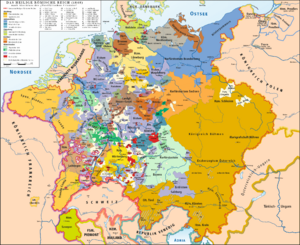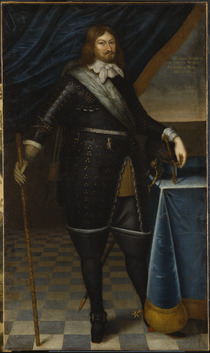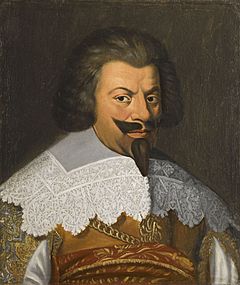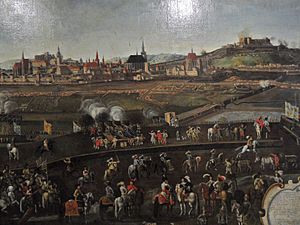Battle of Jankau facts for kids
Quick facts for kids Battle of Jankau |
|||||||
|---|---|---|---|---|---|---|---|
| Part of the Thirty Years' War | |||||||
 Holy Roman Empire ca 1648, Bohemia in brown |
|||||||
|
|||||||
| Belligerents | |||||||
| Commanders and leaders | |||||||
| Strength | |||||||
| 16,000, 60 guns | 16,000, 26 guns | ||||||
| Casualties and losses | |||||||
| 3,000–4,000 killed or wounded | 4,000 killed or wounded 4,450 & 26 guns captured |
||||||
The Battle of Jankau, also known as Jankov, Jankow, or Jankowitz, happened in central Bohemia on March 6, 1645. It was one of the last big battles of the Thirty Years' War, which lasted from 1618 to 1648.
The battle was fought between the Swedish army and the Imperial army. Both sides had about 16,000 soldiers. The Swedish army, led by Lennart Torstensson, was faster and had better leaders. They largely defeated the Imperial army, which was commanded by Melchior von Hatzfeldt.
However, the war had caused so much damage that armies spent most of their time looking for food and supplies. This meant the Swedes couldn't fully use their victory. Imperial forces took back control of Bohemia in 1646. But other battles showed that neither side was strong enough to win the war completely. Even though fighting continued, it made everyone want to talk about peace more urgently. These talks led to the Peace of Westphalia in 1648, which finally ended the war.
Why the Battle Happened

The Thirty Years' War began in 1618. It started when the mostly Protestant leaders in Bohemia offered their crown to Frederick V of the Palatinate, who was also Protestant. This was instead of Emperor Ferdinand II, who was a strong Catholic. Most parts of the Holy Roman Empire stayed neutral at first. The Bohemian revolt was quickly put down.
An army from the Catholic League, paid for by Maximilian of Bavaria, then attacked the Palatinate region. Frederick was forced to leave his home. When Maximilian replaced Frederick as a ruler, the war changed. It brought in Protestant German states like Saxony and Brandenburg-Prussia, and even other countries like Denmark.
In 1630, Gustavus Adolphus of Sweden invaded Pomerania. He wanted to help his fellow Protestants. He also wanted to control the important Baltic Sea trade, which was a big source of money for Sweden.
Sweden kept fighting even after Gustavus died in 1632. But their goals sometimes clashed with German states like Saxony and even their rivals, Denmark. Many of Sweden's Protestant German allies made peace with Emperor Ferdinand II in 1635. After this, the war became less about religion. It turned into a fight between the Empire and Sweden, who was supported by France and George Rákóczi, Prince of Transylvania.
Emperor Ferdinand III became emperor in 1637. He started peace talks in 1643. But he then delayed them, hoping his army would do better after a planned attack in 1644. However, the Swedes first defeated the Danes, who had joined the war to help the Empire. Then, the Swedes destroyed an Imperial army in Saxony.
Even though the Bavarians won a battle at Freiburg in August, they couldn't stop French troops from taking Philippsburg and Lorraine. The Bavarian general, Franz von Mercy, moved his army to Heilbronn for the winter.
For 1645, the Swedish commander Lennart Torstensson planned a three-part attack. He wanted to force Ferdinand III to agree to peace. His plan was to attack in three places at once. This would stop Imperial forces from helping each other. While France attacked Bavaria, Torstensson would lead his army into Bohemia. There, they would meet Rákóczi's forces. Together, they would then march towards Vienna, the Imperial capital.
The Swedish army in Bohemia was about the same size as the Imperial army. But the Swedes were much better organized. Torstensson, despite being sick, was a strong and experienced general with good officers. His opponent, Melchior von Hatzfeldt, was a good leader in battle. But he couldn't control his own commanders, Johann von Götzen and Johann von Werth. Also, many of his soldiers were poorly equipped leftovers from other defeated armies. His best group was 5,000 experienced Bavarian cavalry led by von Werth.
The Battle of Jankau
In late January, Torstensson used the frozen ground to enter Bohemia near Chomutov. The Imperial army was staying for winter near Plzeň. Not sure what the Swedes would do, von Hatzfeldt stayed put to protect Prague. On February 18, the Swedes passed about 18 kilometers (11 miles) to the west. For the next three weeks, both armies tracked each other along the Vltava river.
In early March, a sudden freeze allowed Torstensson to cross the river near Staré Sedlo. Von Hatzfeldt followed, reaching Tábor on March 4, where his cavalry met Swedish soldiers. On March 5, Hatzfeldt moved back to the hills around Jankov. He got ready for battle the next day.
Hatzfeldt chose a strong place for his army. The hills and woods made the Swedish artillery less effective. A stream protected his center, and a steep slope and thick forest protected his right side. His left side was the weakest. It had open ground in front and a hill to the south, called 'Kappellhodjen' or Chapel Hill, overlooking it. The night before, Torstensson and his officers knew the difficulties. But they decided to attack anyway. Their well-planned attack was very different from the mistakes made by the Imperial generals.

The battle happened in two parts. The first part was from dawn until midday. The second part was from early afternoon until nightfall. Around 6:00 AM, a Swedish group led by Robert Douglas pretended to attack the Imperial right side. Meanwhile, the main Swedish force moved around the Imperial left. Hatzfeldt told Götzen to put a small group of soldiers on Chapel Hill. Then, Hatzfeldt left to check on Douglas's move, which he correctly guessed was a trick.
When Hatzfeldt returned, he found that Götzen had misunderstood his orders. Götzen had moved his entire force towards the hill. His soldiers got stuck in the woods and rough ground. This gave the Swedes time to put their artillery and infantry at the top of the hill. After a huge argument, Götzen launched several attacks. But they were pushed back with heavy losses. Just after 9:15 AM, Götzen was killed, and his troops retreated.
Hatzfeldt moved soldiers from the center to cover the retreat of Götzen's men. But unlike the lighter Swedish guns, the Imperial artillery got stuck in the mud. They were captured by Arvid Wittenberg. Cavalry charges led by Werth kept the Swedes away. The two armies stopped fighting just before midday. Torstensson had cleared the road to Olomouc. He decided to let the Imperial army retreat, hoping to reorganize his tired troops before moving on.
However, Hatzfeldt felt the Swedes were too close for him to retreat safely. He chose to stay in his position until nightfall. Seeing this, Torstensson moved his guns forward. He fired at close range into the helpless Imperial infantry. Werth charged and scattered the Swedish right side. But his cavalry stopped to loot the Swedish baggage train, where they captured Torstensson's wife. The Swedish cavalry regrouped and attacked back, causing many losses. Only 1,500 of the 5,000 Bavarian soldiers made it back to Munich.
Left alone, the Imperial infantry surrendered. About 4,450 were taken prisoner, including Hatzfeldt. Another 4,000 were killed or wounded. Out of 36 regiments, only 2,697 men were in Prague a week later. Another 2,000 were scattered in Moravia. The Swedes lost between 3,000 and 4,000 soldiers in total.
What Happened Next

When Ferdinand heard about the defeat, he and his brother Archduke Leopold quickly put together another army. By early May, Leopold had about 15,000 men. This new army couldn't match the experienced Swedish soldiers. But 25 years of constant war had ruined the countryside. Armies spent more time looking for food than fighting. This greatly reduced their ability to keep fighting or hold positions.
This forced Torstensson to try and take the important town of Brno. Brno had an Imperial army of 1,500 soldiers led by de Souches, a French Protestant exile. The Swedes were joined there by 14,200 Transylvanian troops. These troops were mostly unpaid and hungry, which made the supply problems even worse. The armies trying to take Brno lost over 8,000 men from disease, hunger, and soldiers leaving.
The Cretan War started in 1645. Because of this, the Ottomans stopped supporting Rákóczi. In return, Ferdinand renewed an old peace treaty. This forced the Transylvanians to make peace and ended the siege of Brno.
The end of the war with Denmark (which Sweden won) encouraged Torstensson to try one last attack on Vienna. But by October, fewer than 10,000 Swedes faced 20,000 Imperial soldiers. He retreated into Saxony. On December 23, he gave command to Wrangel. By February 1646, the Swedes had been completely pushed out of Bohemia.
However, Ferdinand couldn't also support his allies in Bavaria and Saxony. The French campaign in Bavaria ended in a tie. But Torstensson's three-part plan finally worked when Königsmarck attacked Saxony. With no hope of help, Elector John George agreed to a six-month truce in September 1645. Ferdinand realized that winning the war by fighting was no longer possible. He told his representatives at Westphalia to start serious peace talks.
Images for kids


